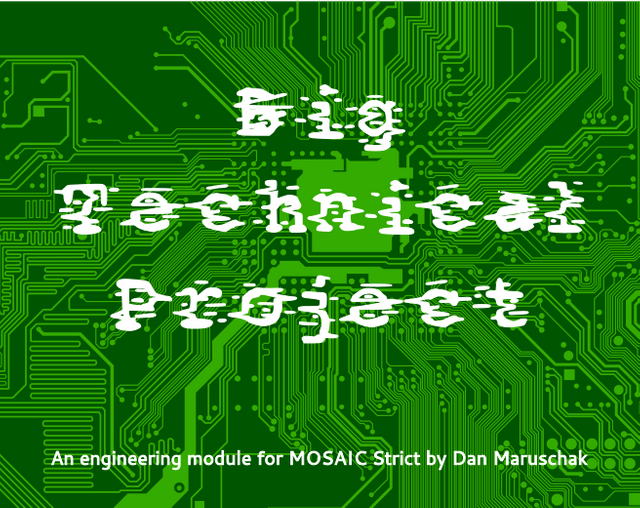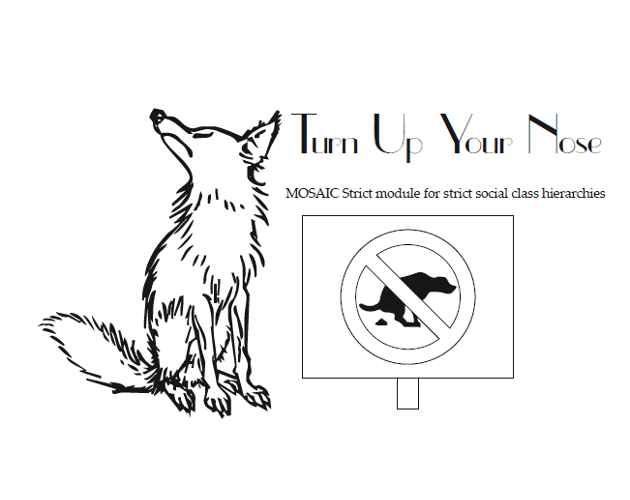
A few months ago, game designer Michael Prescott posted a blog post with an idea for an approach to tabletop RPG design called MOSAIC Strict. I didn't pay much attention at the time, but then I started seeing some twitter buzz about it, especially from Paul Czege, and decided to read it in a little more depth. In addition to some other constraints, the basic idea is to try to design "modules" of subsystems or mechanics that don't try to interact with other systems via defined mechanics but solely through "the fiction". So, for example, you might write a combat system that doesn't refer to something like Hit Points (since that's a game mechanics idea), but it could say something like which bones are broken (since that's something that's happening "in the game-world"). Although I tend to like having some mechanical "connective tissue" between my subsystems, I think it has been a somewhat intriguing idea so I've made a few modules now and and am thinking about making a few more.
Turn Up Your Nose
The first module I published was Turn Up Your Nose. Years ago I read about some psychology studies which were exploring how disgust impacted people's moral decisionmaking. I don't know how well those studies have held up during the Replication Crisis, but the idea of trying elicit feelings of disgust has always seemed to me like an interesting gimmick to incorporate into a game. Since MOSAIC Strict modules are optional, I figured that this would be a good format for trying outside-the-box ideas, without having to worry about whether I could build a whole game around them. The basic idea in this module is using disgust to have players experience disgust when interacting across class boundaries in a highly-stratified culture.
Caretaker

In some twitter discussions about MOSAIC Strict, I saw the suggestion that one thing holding people back from actually trying out MOSAIC Strict games was that nobody (at that time) had created any character generation systems for it. That made me think of one of my stuck-in-development games, Getting There in Time, which is a Doctor Who-with-the-serial-numbers-filed-off game. I had a character creation subsystem that I liked in the game, but other parts of it weren't working great in playtests. But I decided to adapt that character system, which was already somewhat self-contained, to be completely MOSAIC Strict compliant and released it as Caretaker. A lot of RPG character systems focus on what you can do, which makes them hard to incorporate into a MOSAIC Strict framework since that's often a different subsystem, but this one is more focused on who you are and what you tend to do, so I think it's actually a pretty good fit for the MOSAIC Strict framework.
Big Technical Project

The tweet that initially got me going down the MOSAIC Strict path was when Paul prompted people to think of a MOSAIC Strict module that only they would write. At the time my best answer was that I could adapt my "software development" subsystem from my game Sunshine Over My Shoulder. That game is satirical, but part of what I think makes it work as a satire is that it's trying to be pretty earnest about what it's like to work on a complex technical project. It turned out to be harder to adapt than I thought, which is why this was the third module I released even though it was the first one I started thinking about. Basically I had to figure out some ways to make the mechanics more self-contained, and then I had to do some work to fit the rules within the 1500-word constraints of MOSAIC Strict. And I also wanted to be a little more ambitious with the graphic design on this one (although I am not very skilled at that), so I also had to do some work to figure out how to do that while also keeping within the constraint of fitting on a two-page spread. In the end I think I'm pretty happy with Big Technical Project, I think it could be used in a variety of situations and a lot of different tones. I think it could do a contemporary slice-of-life situation in a tech company, but I think it could also do a lot of different types of sci-fi (or fantasy, depending on how you interpret "technical"). I'm hoping that these mechanics capture something of the experience of building things that can sometimes end up feeling very abstract and disconnected in RPGs where you're just doing something like making a craft roll.
I have some other ideas for other modules I want to make. I don't know how practical this is in terms of anyone actually playing games with these modules, but it feels like this is a way for me to express some game design creativity that's more "open" than needing to have a fully-functional game that I'm confident in.
